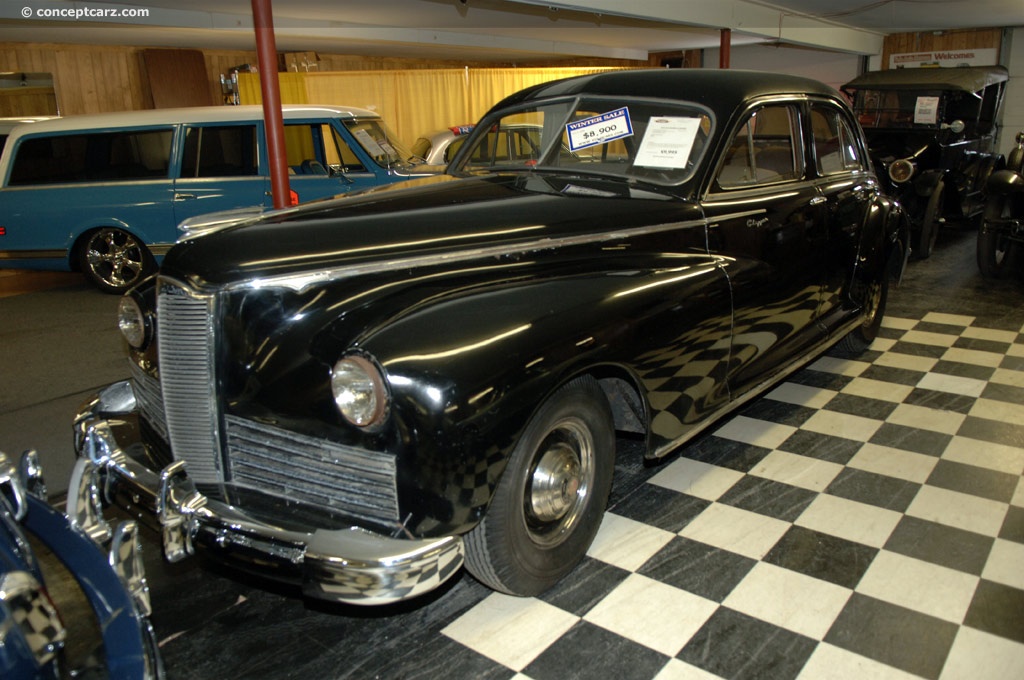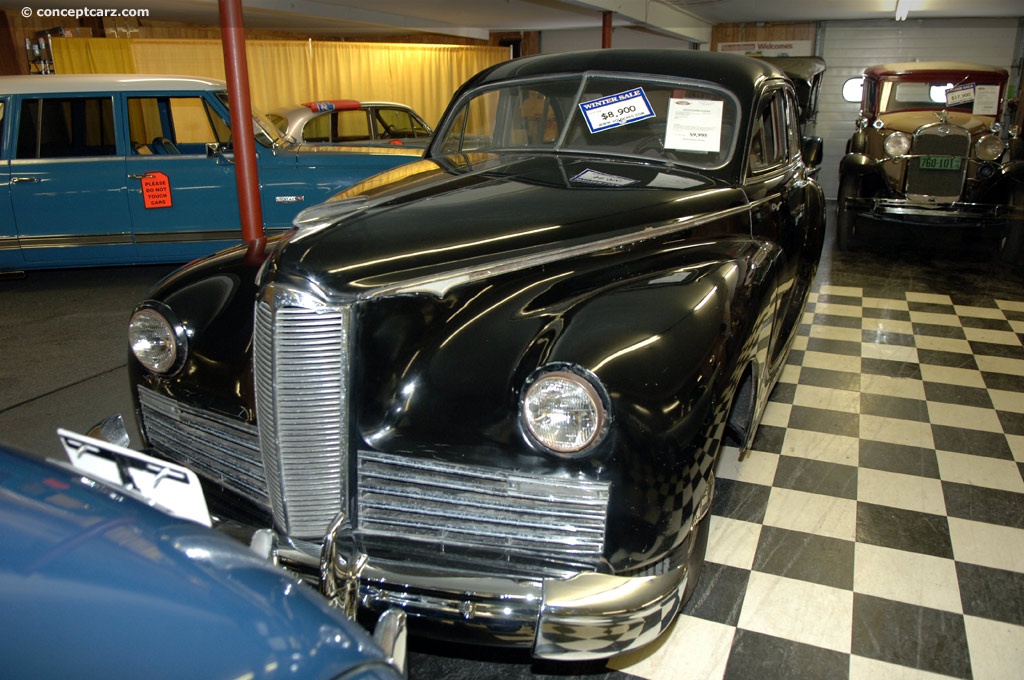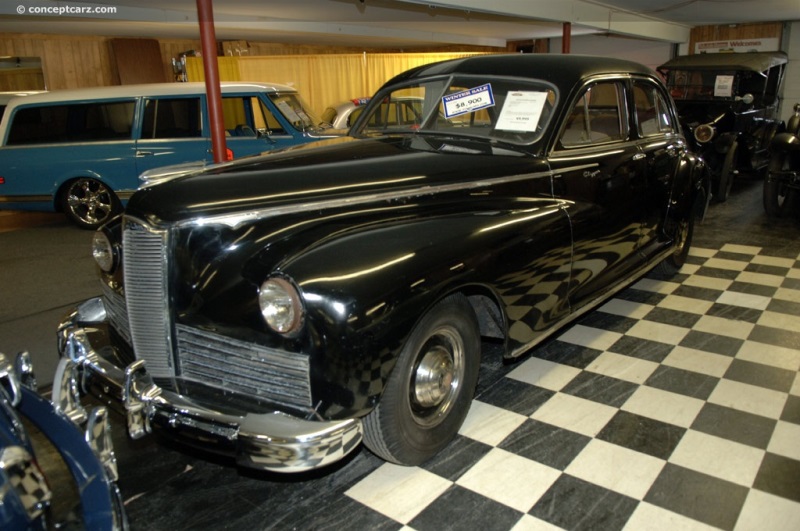Packard offered a diverse lineup of vehicles for 1941, beginning with the six-cylinder Packard One-Ten and the eight-cylinder Packard One-Twenty, priced in similar territory to the Studebaker Commander, Plymouth P12 Special DeLuxe, Chrysler Series 28, and the Chevrolet Special Deluxe. The One-Ten rested on a generous 122-inch wheelbase that was larger than most other vehicles at its price point. The Packard One-Twenty used a 127-inch wheelbase and was equipped with a 282 cubic-inch straight-8 with five main bearings, a Carter carburetor, and delivered 120 horsepower at 3,600 RPM. The Super-8 One-Sixty and Super-8 One-Eighty had the same engine and wheelbase dimensions, differing in construction and the level of trim and interior appointments. The One-Sixty wore factory-built bodies while the One-Eighty were bodied by outside coachbuilders. The eight-cylinder One-Twenty had joined the Packard lineup in 1935 and its affordable price and renowned craftsmanship made it immensely popular, ultimately saving the company from immediate demise. The success spurred another move downmarket with the introduction of the six-cylinder One-Ten two years later, resulting in even higher sales volume. The sales revival was short-lived, as sales plummeted as the depression returned in 1938. Approximately 122,600 Packard vehicles had been built in 1937, falling to nearly 56,000 in 1938, and just over 46,400 in 1939. Although these figures were much higher than in the early 1930s (approximately 4,800 examples were built in 1932), they were barely above the break-even point and profitability was minimal. This delicate financial situation left precious few resources for further development and modernization. To save the company and compete against LaSalle, Cadillac, and the Lincoln-Zephyr, Packard president Max M. Gilman realized that new products, new designs, and new technology were paramount. To that end, the company introduced the Packard Clipper in April of 1941 as a mid-market model, just eight months prior to the attack on Pearl Harbor.Packard Clipper Engineering
The Clipper received a 127-inch wheelbase and rode on 7.00x15 tires, the same wheelbase size as the One-Twenty and the Super-8 (the Super-8 also had wheelbase sizes of 138- and 148-inches). The L-head, straight-8 engine had a 282 cubic-inch displacement, a carter carburetor, adjustable valve lifters, five main bearings, 6.85:1 compression, and delivered 125 horsepower at 3,600 RPM. This was the same engine powering the One-Twenty, but a higher compression setting on the Clipper resulted in five additional horsepower. Despite the similarities, a few parts were interchangeable with other Packard models. The chassis dimensions were common to the Packard line, but it was an entirely new double-drop frame design, resulting in a lower floor but without sacrificing road clearance. Although the Clipper used a familiar wheelbase size, many of its other dimensions were unique. It holds the distinction of being the first production car to be wider than it was tall (by a foot).Due to the lower frame, Packard's traditional long torque arms were replaced by a new suspension setup. The engine was mounted much farther forward in the engine bay, so Packard engineers angled the rear shocks to assist the traditional Packard fifth shock in controlling side sway. The steering brackets and the Pitman arm were connected via a double-link setup, along with a crossbar and idler arm and two cross tubes. The battery was moved from under the seat to the engine bay, greatly improving its accessibility. The hood could be lifted from either side of the car, or completely removed by toggling two levers. An accelerator-activated starter button set the automatic choke during start-up, and a 'Ventalarm' whistle warned when the tank was running low and had just a gallon left. Flow-through ventilation was provided by ventipanes incorporated into the rear doors, and the traditional third-side window was removed. Packard Clipper Styling
A single piece of steel was used from the cowl to the rear deck, making it the largest in the industry, and the floor pan used a single welded seam from end to end. The rear quarters and hoods also used single pieces of sheet metal. The headlamps were incorporated into the fenders, and a narrow, slanting horizontal grille was at the tip of the hood, flanked on either side (below the headlights) by horizontal grille extensions. In front was a heavy chrome grille with bumper guards. Chrome tripe traversed on either side of the hood, and continued through the side of the door, ending partway through. Chrome trim ran along the bodyside, and around the windows. The exterior design of the Clipper was reportedly created with consultation from Howard 'Dutch' Darrin, who had come to America in 1937 after a successful career as a Paris coachbuilder. The existing Packard designs appealed to Darrin, who built custom-bodied Packards with only minor changes to their basic structure. These Packard-Darrin designs eventually became part of the Packard company's catalog and led to Darrin's participation in designing the Clipper. Along with Packard's chief styling (vice-president of design) Ed Macauley - Packard credited the design to 'three international designers.' Along with Darrin, the other two were Briggs and George Walker. An air of controversy and mystery surrounds the actual creator of the design, as Darrin has claimed to be the originator and central design figure for the overall design and presentation. Darrin claimed to have been given ten days to create the design and was promised a thousand dollars per day, yet was never paid or properly acknowledge as its creator. He also claims that many of the design features were 'vandalized' and drastically altered or removed. Regardless, the design was modern and allowed Packard to shed its traditional bodies and embrace modern styling that was enveloping the entire industry, led by GM's new C bodies and Ford's wind-swept Zephyr. Chrysler had momentarily stumbled with its radically aerodynamic Airflow but had regained its balance as the 1940s had come into view. Production
The Packard Clipper's introduction was both good and bad - although its initial production was cut short due to World War II, its late arrival to Packard's production line meant that Packard had, essentially, an all-new design when civilian automobile production resumed after the war. Sales following the war were hindered due to material shortages and strikes at vendors, a common problem among all independent automobile manufacturers. The 1941 Packard Clipper was offered solely as a touring sedan with seating for five and priced a $1,420, which positioned it below the Super-8 (the lowest-priced Super-8 was the business coupe priced at $1,600), and in the same territory as the One-Twenty ($1,140 to $1,750). Packard's most popular model for 1941 was the One-Ten with 34,700 examples sold, followed by 17,100 of the One-Twenty. Despite its lack of body styles, the Clipper had nearly the same amount of sales as the One-Twenty, with 16,600 examples sold. The Super-8 One-Sixty had 3,525 sales and the top-of-the-line One-Eighty had 930 sales. Post War
The Clipper designation was expanded following World War II, with models that included the Clipper Six, Clipper Standard Eight, Clipper Deluxe Eight, Super Clipper Eight, and Custom Super Clipper Eight. After 1947, the name 'Clipper' was dropped and the models became the Standard and Deluxe Eight, Super Eight, and Custom Eight. The Clipper name returned in 1953 and was used until 1955. Packard's president James Nance wanted to restore the prestige of the Packard name in the mid-1950s, by creating a second company that would cater to a wide audience of buyers, while the Packard would handle the exclusive and limited-production line. The 'bread-and-butter' company was the Packard Clipper division within Studebaker-Packard, and the company's logo was a ship's wheel and were devoid of Packard's nameplate. After dealers and buyers complained about the lack of 'Packard' insignia, a small 'Packard' script emblem was placed on the decklids of newly built Clippers. Emblems were also made available for placement on existing cars, both in customers' driveways and on dealers' lots. Packard was in deep financial trouble, and the acquisition of the Studebaker Corporation of South Bend, Indiana (which greatly increased its dealer network, factories, product line, engines, technology, and resources) resulting in the Studebaker-Packard Corporation of 1954, did not help the company's perspective. After a disastrous sales year in 1956, Packard's president Nance resigned and Studebaker-Packard entered a management agreement with the Curtiss-Wright Corporation. Major changes followed, including the end of Packard's production in Detroit, and all remaining automotive operations were sent to South Bend. It was too little too late, however, and the final Packard automobile rolled off the assembly line in July of 1958.
by Daniel Vaughan | Mar 2021
The Clipper received a 127-inch wheelbase and rode on 7.00x15 tires, the same wheelbase size as the One-Twenty and the Super-8 (the Super-8 also had wheelbase sizes of 138- and 148-inches). The L-head, straight-8 engine had a 282 cubic-inch displacement, a carter carburetor, adjustable valve lifters, five main bearings, 6.85:1 compression, and delivered 125 horsepower at 3,600 RPM. This was the same engine powering the One-Twenty, but a higher compression setting on the Clipper resulted in five additional horsepower. Despite the similarities, a few parts were interchangeable with other Packard models. The chassis dimensions were common to the Packard line, but it was an entirely new double-drop frame design, resulting in a lower floor but without sacrificing road clearance. Although the Clipper used a familiar wheelbase size, many of its other dimensions were unique. It holds the distinction of being the first production car to be wider than it was tall (by a foot).Due to the lower frame, Packard's traditional long torque arms were replaced by a new suspension setup. The engine was mounted much farther forward in the engine bay, so Packard engineers angled the rear shocks to assist the traditional Packard fifth shock in controlling side sway. The steering brackets and the Pitman arm were connected via a double-link setup, along with a crossbar and idler arm and two cross tubes. The battery was moved from under the seat to the engine bay, greatly improving its accessibility. The hood could be lifted from either side of the car, or completely removed by toggling two levers. An accelerator-activated starter button set the automatic choke during start-up, and a 'Ventalarm' whistle warned when the tank was running low and had just a gallon left. Flow-through ventilation was provided by ventipanes incorporated into the rear doors, and the traditional third-side window was removed. Packard Clipper Styling
A single piece of steel was used from the cowl to the rear deck, making it the largest in the industry, and the floor pan used a single welded seam from end to end. The rear quarters and hoods also used single pieces of sheet metal. The headlamps were incorporated into the fenders, and a narrow, slanting horizontal grille was at the tip of the hood, flanked on either side (below the headlights) by horizontal grille extensions. In front was a heavy chrome grille with bumper guards. Chrome tripe traversed on either side of the hood, and continued through the side of the door, ending partway through. Chrome trim ran along the bodyside, and around the windows. The exterior design of the Clipper was reportedly created with consultation from Howard 'Dutch' Darrin, who had come to America in 1937 after a successful career as a Paris coachbuilder. The existing Packard designs appealed to Darrin, who built custom-bodied Packards with only minor changes to their basic structure. These Packard-Darrin designs eventually became part of the Packard company's catalog and led to Darrin's participation in designing the Clipper. Along with Packard's chief styling (vice-president of design) Ed Macauley - Packard credited the design to 'three international designers.' Along with Darrin, the other two were Briggs and George Walker. An air of controversy and mystery surrounds the actual creator of the design, as Darrin has claimed to be the originator and central design figure for the overall design and presentation. Darrin claimed to have been given ten days to create the design and was promised a thousand dollars per day, yet was never paid or properly acknowledge as its creator. He also claims that many of the design features were 'vandalized' and drastically altered or removed. Regardless, the design was modern and allowed Packard to shed its traditional bodies and embrace modern styling that was enveloping the entire industry, led by GM's new C bodies and Ford's wind-swept Zephyr. Chrysler had momentarily stumbled with its radically aerodynamic Airflow but had regained its balance as the 1940s had come into view. Production
The Packard Clipper's introduction was both good and bad - although its initial production was cut short due to World War II, its late arrival to Packard's production line meant that Packard had, essentially, an all-new design when civilian automobile production resumed after the war. Sales following the war were hindered due to material shortages and strikes at vendors, a common problem among all independent automobile manufacturers. The 1941 Packard Clipper was offered solely as a touring sedan with seating for five and priced a $1,420, which positioned it below the Super-8 (the lowest-priced Super-8 was the business coupe priced at $1,600), and in the same territory as the One-Twenty ($1,140 to $1,750). Packard's most popular model for 1941 was the One-Ten with 34,700 examples sold, followed by 17,100 of the One-Twenty. Despite its lack of body styles, the Clipper had nearly the same amount of sales as the One-Twenty, with 16,600 examples sold. The Super-8 One-Sixty had 3,525 sales and the top-of-the-line One-Eighty had 930 sales. Post War
The Clipper designation was expanded following World War II, with models that included the Clipper Six, Clipper Standard Eight, Clipper Deluxe Eight, Super Clipper Eight, and Custom Super Clipper Eight. After 1947, the name 'Clipper' was dropped and the models became the Standard and Deluxe Eight, Super Eight, and Custom Eight. The Clipper name returned in 1953 and was used until 1955. Packard's president James Nance wanted to restore the prestige of the Packard name in the mid-1950s, by creating a second company that would cater to a wide audience of buyers, while the Packard would handle the exclusive and limited-production line. The 'bread-and-butter' company was the Packard Clipper division within Studebaker-Packard, and the company's logo was a ship's wheel and were devoid of Packard's nameplate. After dealers and buyers complained about the lack of 'Packard' insignia, a small 'Packard' script emblem was placed on the decklids of newly built Clippers. Emblems were also made available for placement on existing cars, both in customers' driveways and on dealers' lots. Packard was in deep financial trouble, and the acquisition of the Studebaker Corporation of South Bend, Indiana (which greatly increased its dealer network, factories, product line, engines, technology, and resources) resulting in the Studebaker-Packard Corporation of 1954, did not help the company's perspective. After a disastrous sales year in 1956, Packard's president Nance resigned and Studebaker-Packard entered a management agreement with the Curtiss-Wright Corporation. Major changes followed, including the end of Packard's production in Detroit, and all remaining automotive operations were sent to South Bend. It was too little too late, however, and the final Packard automobile rolled off the assembly line in July of 1958.
by Daniel Vaughan | Mar 2021
Related Reading : Packard Clipper History
When the Packard Company began automobile production in 1899, it was known as Ohio Automobile Company. In 1903 the name was changed to the Packard Motor Car Company when it moved from Warren, Ohio to Detroit, Michigan. The move was the result of a majority stock purchase made by investors in the Detroit area. Packard had sustained a Great Depression and a World War and was still at the fore-front....
Continue Reading >>
Continue Reading >>
Similar Automakers
Similarly Sized Vehicles
from 1941
Similarly Priced Vehicles
1941 Packard Clipper Vehicle Profiles
Recent Vehicle Additions
Performance and Specification Comparison
Price Comparison
$1,000 - $1,325
$1,135 - $1,784
$1,622 - $2,400
$2,600 - $5,600
Clipper Specification Comparison by Year
Year
Production
Wheelbase
Engine
Prices
672
127.00 in., 138.00 in., 148.00 in.
8 cyl., 356.00 CID., 165.00hp
$2,100 - $5,795
2,763
127.00 in., 148.00 in.
8 cyl., 356.00 CID., 165.00hp
$2,910 - $4,500
7,480
127.00 in., 148.00 in.
8 cyl., 356.00 CID., 165.00hp
$3,145 - $4,520
38,804
127.00 in.
8 cyl., 282.00 CID., 125.00hp
8 cyl., 356.00 CID., 165.00hp
8 cyl., 356.00 CID., 165.00hp
$1,700 - $2,150
Related Automotive News

Auctions America's 2013 Auburn Spring Event Offers Ultimate Collector Car Weekend
Auctions America presents the first of two annual Auburn sales, May 9 – 11 at historic Auburn Auction Park in Auburn, Indiana
Multi-day sale lifts gavel on 600 quality collector cars and an assortment of memorabilia
Notable early highlights in...

Magnificent Series of Coachbuilt Classics To Grace RM's Amelia Island Concours D'Elegance Sale
RM Auctions returns as the official auction house of the Amelia Island Concours dElegance, March 9, 2013
Single-day sale features breathtaking roster of more than 80 investment-quality collector cars
Notable highlights include an outstanding s...

Mercedes-Benz Classic at the 2012 Grossglockner Grand Prix
Revival of the mountain race from the 1930s
Mercedes-Benz SSK and W 125 at the start
92 bends, 14 hairpins, 15 kilometres and a 1300-metre altitude difference
The Grossglockner mountain race was one of the most prestigious motor sports event...

The Champion in Touring Car Racing : The BMW M3
In August 1985, a rumour surfaced in motor magazine Auto-Deutschland which emanated from a new sports car. An A Group Car from BMW that was a thoroughbred racing car according to the rules but was also to be produced in a version licensed to drive on...

Auctions America By RM's 2012 Auburn Spring Auction
Variety is the buzzword for this years Auctions America by RM June 1-3 Auburn Spring auction, which will offer a huge range of collector vehicles and an enormous private collection of automotive memorabilia. More than 600 American muscle cars, Classics,...



















